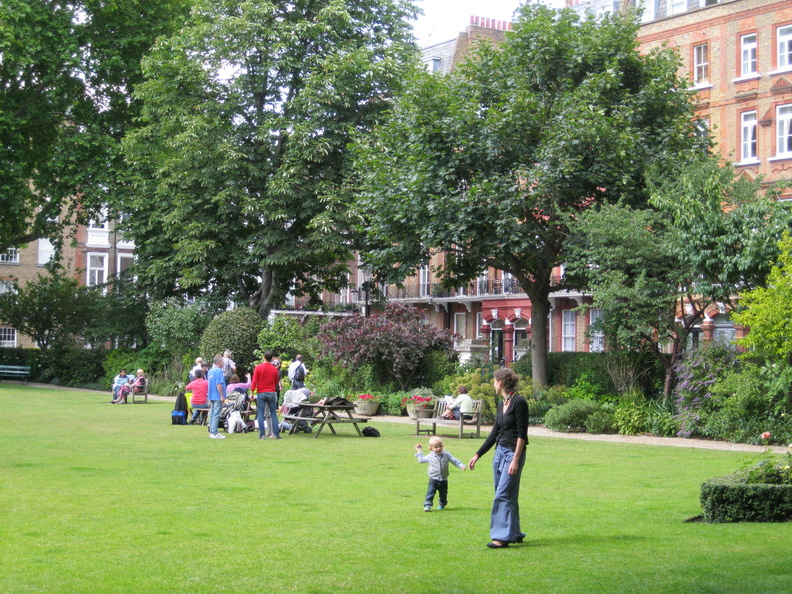Nevern Square Garden (Kensington & Chelsea)
Brief Description
These private communal gardens were provided for the residents of Nevern Square, built in 1880-82 as part of the development of the Edwardes Estate. The garden was laid at an early stage of the development. William Edwardes, whose father had married into the Rich family who owned the Earl's Court Estate, had become Baron Kensington in 1776 and by the early C19th it was the largest estate in Kensington. The family's links with Pembrokeshire are reflected in street names, Nevern or Nanhyfer taken from a Welsh parish and river. The garden was purchased by local residents in 1974, who formed a non-profit-making company. Seven plane trees may have been part of the original planting, and the garden has a wide variety of trees.
Practical Information
- Site location:
- Nevern Square
- Postcode:
- SW5 9NW
- What 3 Words:
- dunes.shade.soak
- Type of site:
- Garden Square
- Borough:
- Kensington & Chelsea
- Open to public?
- Occasionally
- Opening times:
- Has opened for OGSW. Otherwise private, for keyholders only
Has taken part in Open Garden Squares Weekend 20 times, most recently in 2025. - Special conditions:
- no dogs except at certain times
- Facilities:
- Children's sand pit, swings
- Events:
- Public transport:
- Tube: Earl's Court (District, Piccadilly). Bus: C1, C3, 74, 328
- Research updated:
- 01/10/2007
- Last minor changes:
- 19/07/2023
Please check with the site owner or manager for latest news. www.nevernsquaregarden.co.uk
Full Site Description
Nevern Square is part of the Edwardes estate, in the early C19th the largest estate in Kensington consisting of 3 adjoining areas that together comprised c.250 acres. In 1721 the Earl's Court estate lands belonging to the Rich family, Earls of Warwick and Holland, were inherited by Elizabeth, aunt of Edward Henry Rich, who was married to Francis Edwardes of Haverfordwest in Pembrokeshire. Their third son William inherited the property here in 1738 and was later created Baron Kensington in 1776. The links with Pembrokeshire were further strengthened with his marriage to Elizabeth Warren of Longbridge, Pembrokeshire, and many of the street names reflect this when the Kensington estate was later developed; Nevern (Nanhyfer) comes from a Welsh parish and church taking the name from the river Nevern. However much of the estate remained agricultural until well into the C19th, with over 190 acres occupied by Earl's Court Farm, tenanted by the family of Samuel Hutchins from 1720, who lived in the Manor House. The relatively late development of the estate lands was partly due to the financial difficulties of the 2nd and 3rd Barons.
Nevern Square was developed by Robert Whitaker from 1880, who paid £250 an acre for the land. Whitaker had already built Nevern Place in 1874/6. In 1877 Lord Kensington's surveyor, Martin Stutely and his son-in-law Daniel Cubitt Nichols were granted permission to alter the permitted plans of this area, and when Cubitt Nichols replaced Stutely as Lord Kensington's adviser his taste for the new Domestic Revival style influenced Whitaker's Nevern Square, whose architect was Walter Graves. In the prospectus for Nevern Square each house had a relatively high ground rent of £23; the garden square was formed at an early stage of building and the occupants paid an annual rent of 2 guineas for its maintenance. An advertisement for the 'Substantial Family Residences' of Nevern Square includes an artist's impression of its garden square showing railings, perimeter trees and an elaborate path layout around a central feature. In 1928, in the ownership of Lord Iveagh, the garden was accessible to lessees of the surrounding houses, with licenses additionally granted to residents of the flats in Nevern Mansions, on payment of a garden rent. At that time it was maintained by Lord Iveagh as the ground landlord and had 'a lawn with trees and shrugs around the border'
The central garden today is framed on one side by yellow and red brick houses in the Queen Anne spirit, built between 1880-86; on the other side are subdued Italian villas with heavy paired porches. The square itself is lozenge shaped and wider to the north. The garden has 7 mature plane trees that may have formed part of the original planting, and among other trees are a wide variety including horse chestnut trees. A central lawn is surrounded by shrub and herbaceous borders. It is protected under the 1851 Garden Square Act. In 1974 Nevern Square Garden Ltd was established by local residents who purchased the freehold and took responsibility for the garden's maintenance. As a child in the early C20th the writer Compton Mackenzie lived at No.1 Nevern Square.
Sources consulted:
OGSW booklet 2004; RBKC Nevern Square and Philbeach Conservation Areas Proposals Statement, 1998; Bridget Cherry and Nikolaus Pevsner, 'The Buildings of England London 3: North West' (Penguin, 1999 ed); Report of the Royal Commission on London Squares, 1928
Further Information (Planning and Conservation)
- Grid ref:
- TQ252785 (525269,178552)
- Size in hectares:
- 0.4666
- Site ownership:
- Nevern Square Garden Ltd
- Site management:
- Nevern Square Garden Ltd
- Date(s):
- 1877
- Designer(s):
- Listed structures:
- None
- On National Heritage List for England (NHLE), Parks & Gardens:
No- Registered common or village green on Commons Registration Act 1965:
No- Protected under London Squares Preservation Act 1931:
Yes
Local Authority Data
The information below is taken from the relevant Local Authority's planning legislation, which was correct at the time of research but may have been amended in the interim. Please check with the Local Authority for latest planning information.
- On Local List:
- No
- In Conservation Area:
- Yes
- Conservation Area name:
- Nevern Square
- Tree Preservation Order:
- Not known
- Nature Conservation Area:
- No
- Green Belt:
- No
- Metropolitan Open Land:
- No
- Special Policy Area:
- No
- Other LA designation:
- None
Photos
Nevern Square - Photo: Colin Wing
Date taken: 11/06/11 16:08Click a photo to enlarge.
Please note the Inventory and its content are provided for your general information only and are subject to change. It is your responsibility to check the accuracy.





